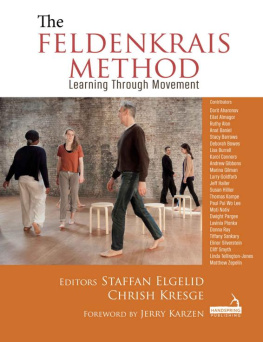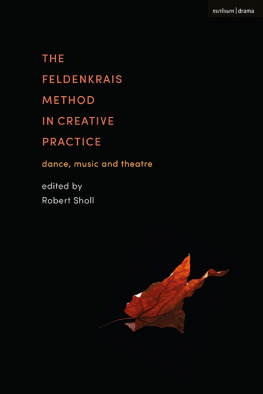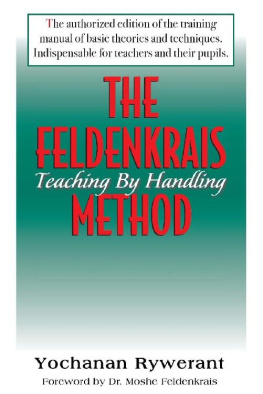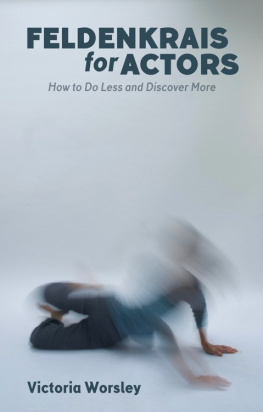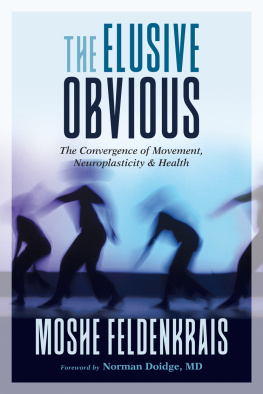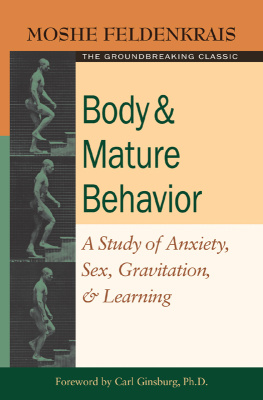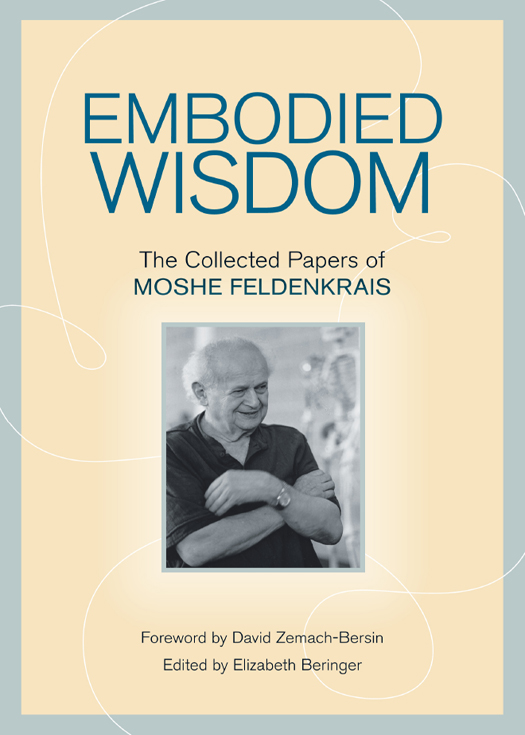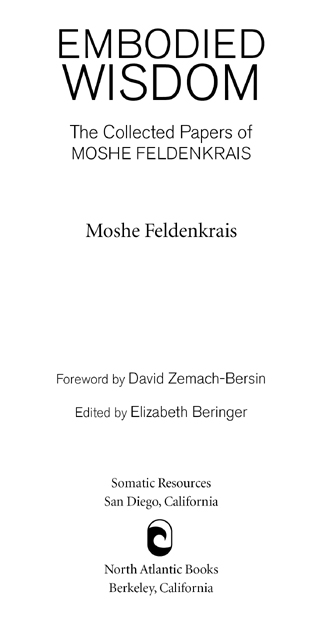Also by MOSHE FELDENKRAIS
Body and Mature Behavior:
A Study of Anxiety, Sex, Gravitation, and Learning
The Potent Self: A Study of Spontaneity and Compulsion
Awareness Through Movement
Body Awareness as Healing Therapy: The Case of Nora
The Elusive Obvious
The Master Moves
Practical Unarmed Combat
Judo: The Art of Defense and Attack
Higher Judo: Groundwork
Copyright 2010 by Somatic Resources and the Feldenkrais Estate. All rights reserved. No portion of this book, except for brief review, may be reproduced, stored in a retrieval system, or transmitted in any form or by any meanselectronic, mechanical, photocopying, recording, or otherwisewithout the written permission of the publisher. For information contact North Atlantic Books.
| Published by | and |
| Somatic Resources | North Atlantic Books |
| 3680 Sixth Avenue | P.O. Box 12327 |
San Diego, California 92103
| Berkeley, California 94712
|
| Cover photo by Lionel Delevingne | Photos 2010. See for photo credits. |
| Cover and book design by Suzanne Albertson | Photos on are used with |
| permission from the International Feldenkrais |
| Federation. |
Photographs by Michael Wolgensinger appear courtesy of the Wolgensinger archive, leawolgensinger@simplicity.ch.
Bodily Expression, Somatics, Vol. 6, No. 4, Spring/Summer 1988. Translated from the French by Thomas Hanna. Bodily Expression (Conclusion), Somatics, Vol. 7, No. 1, Autumn/Winter 198889. On the Primacy of Hearing, Somatics, Vol. 1, No. 1, Autumn 1976. Man and the World, Somatics, Vol. 2, No. 2, Spring 1979. Reprinted by permission of Somatics magazine.
Feldenkrais, Moshe. Edited and translated by Kelly Morris, Image, Movement, and Actor: Restoration of Potentiality. TDR: The Drama Review volume 10: number 3, T31, Spring, 1966. Reprinted by permission of the publisher. Rott, Joanne. Feldenkrais Revisited: Tension, Talent, and the Legacy of Childhood. Courtesy of Joanne Rott.
Embodied Wisdom: The Collected Papers of Moshe Feldenkrais is sponsored by the Society for the Study of Native Arts and Sciences, a nonprofit educational corporation whose goals are to develop an educational and cross-cultural perspective linking various scientific, social, and artistic fields; to nurture a holistic view of arts, sciences, humanities, and healing; and to publish and distribute literature on the relationship of mind, body, and nature.
North Atlantic Books publications are available through most bookstores. For further information, visit our website at www.northatlanticbooks.com or call 800-733-3000.
Feldenkrais, Feldenkrais Method, Functional Integration, Awareness Through Movement, and Guild Certified Feldenkrais Practitioner are service marks of the Feldenkrais GUILD of North America.
Library of Congress Cataloging-in-Publication Data
Feldenkrais, Mosh, 19041984.
Embodied wisdom: the collected papers of Mosh Freldenkrais / Mosh Feldenkrais; edited by
Elizabeth Beringer.
p.; cm.
eISBN: 978-1-58394-419-6
1. Feldenkrais method. I. Beringer, Elizabeth. II. Title. [DNLM: 1. Feldenkrais, Mosh, 19041984.
2. PsychophysiologyCollected Works. 3. PsychophysiologyInterview. 4. Body ImageCollected Works. 5. Body ImageInterview. 6. Motor ActivityCollected Works. 7. Motor ActivityInterview. 8. Self ConceptCollected Works. 9. Self ConceptInterview. WL 103 F312e 2010]
RC489.F44F4423 2010
616.800922dc22
2010020233
v3.1
Dedicated to all the Feldenkrais practitioners worldwide
who are putting Moshe Feldenkraiss ideas into action.
MEDICAL DISCLAIMER: The following information is intended for general information purposes only. Individuals should always see their health care provider before administering any suggestions made in this book. Any application of the material set forth in the following pages is at the readers discretion and is his or her sole responsibility.

Moshe Feldenkrais 19041984
Contents
Foreword
I believe that the unity of mind and body is an objective reality. They are not just parts somehow related to each other, but an inseparable whole while functioning. A brain without a body could not think the muscles themselves are part and parcel of our higher functions.
MOSHE FELDENKRAIS , from the article Mind and Body, 1964
Movement is life. Life is a process. Improve the quality of the process and you improve the quality of life itself.
MOSHE FELDENKRAIS , from Awareness Through Movement, 1973
MOSHE FELDENKRAIS WAS ONE OF THE TWENTIETH CENTURYs most original and integrative thinkers. Along with such seminal figures as Ida Rolf, Heinrich Jacoby, F. M. Alexander, and Elsa Gindler, Feldenkrais is considered one of the founders of the field that is today called Somatics. The pieces included in Embodied Wisdom: The Collected Papers of Moshe Feldenkrais were originally published in independent journals between 1964 and 1998. A testament to the prescience of Feldenkraiss ideas is the fact that many of the concepts presented in this volume are as important, generative, and radical today as they were when they were first articulated. In these remarkable articles and interviews, Feldenkrais provides us with some of the most cogent and sophisticated arguments ever made for the biological and functional unity of the mind and body.
During most of the twentieth century, the dominant medical and academic model of the brain was that our habits are fixed or hard-wired, that each area of the brain has specialized, pre-determined functions, and that every day of our adulthood, our brain loses both neurons and the ability to learn new skills. In books, articles, and lectures from 1949 to 1981, Moshe Feldenkrais strongly challenged this point of view, not simply the theory behind it, but in practice, by developing innovative exercises and clinical applications that effectively demonstrated thateven when damagedthe brain has the ability to quickly change, and to learn new skills and recover lost functions.
Today, a new paradigm is taking hold in neuroscience, psychology, and rehabilitation: the concept of brain plasticity, or neuroplasticity, which posits that throughout our entire life span, our brain has the capacity to modify its organization and responses through experience and learning. If Feldenkrais were alive, he would find todays research supporting neuroplasticity a sweet validation.
In April 1973, when I first observed Dr. Feldenkrais working, it was clear that he believed in each persons capacity to learn and change. Feldenkrais was teaching a month-long seminar in Berkeley, where I was a pre-med student at the University of California. After my regular courses, I would sneak into the classroom where he was teaching. What I saw there was extraordinary.
Each day, as part of his seminar, Feldenkrais would work for one hour with a middle-aged man named Edward, who had severe spastic cerebral palsy. On my first day observing, Edwards speech was nearly impossible to understand, his arms were hyper-flexed and pulled up near his chest, his hands twisted inward, and he moved slowly with a halting, effortful gait. Since early childhood, Edward had received the best physical therapy and medical attention possible.





